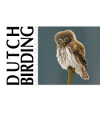Dutch Birding volume 31 (2009) no 2

Siberian Chiffchaffs in the Netherlands: occurrence and identification
This paper summarizes the occurrence of Siberian Chiffchaff Phylloscopus collybita tristis in the Netherlands and discusses the identification of this taxon. Tristis is a rare visitor, first recorded in 1985, and is considered by the Dutch rarities committee (CDNA). Table 1 gives an overview of records up to early 2008 (28, involving 29 individuals); birds have been found in October (9), November (13), December (4), January (1), February (1) and April (1), which shows that tristis is predominantly a late autumn vagrant, with scattered records in winter and early spring. Some individuals have stayed for several months. In recent years, the number of reports has increased strongly and many reports, mainly from 2005-09, have not yet been submitted or are still under consideration; a selection of these reports is given in table 2. Table 3 lists reports that had formerly been accepted but that have now been rejected after review, because of the recently sharpened criteria for acceptance. Most records come from coastal sites, with just a few inland. Six birds haven been trapped and ringed. The criteria for acceptance by the CDNA are listed in the appendix. Records can only be accepted if a combination of sound-recordings (song and/or call) and photographs is available; by exception, if high-quality photographs are available (eg, of birds in the hand), acceptance can be possible without sound-recordings. According to the CDNA criteria, both 'grey' and 'brown' birds can be acceptable, provided the sound-recordings match the typical song and/or call of tristis. On plumage alone, in the field, 'grey' birds can not safely be separated from some Common Chiffchaffs of the northern subspecies P c abietinus.
A summary is given of records in other countries in northern and western Europe (Denmark: 35 up to 1995; Finland: 62 up to 2001; Germany: 19 up to 1998; Latvia: eight up to 1999; Norway: three up to 1999; and Sweden: 108 up to 2003). Tristis is not considered in, eg, Britain and Ireland but in 2008 the British rarities committee has started to collect submissions for future consideration. The criteria for possible acceptance differ from country to country in Europe, with several countries not (yet) accepting 'grey' birds. Both morphology and vocalizations are discussed with references to a large number of recent publications about the (presumed) variability in morphology and vocalizations of tristis, compared with abietinus and nominate P c collybita. Recent research in southern Kazakhstan (where tristis is a common migrant and other chiffchaff taxa have not been recorded) indicates that tristis is highly variable in plumage, whereas the typical 'sad' call and the song are constant features. These conclusions support the policy of the CDNA to give much weight to the documentation of vocalizations when considering tristis reports. For more information in English on the vocalizations, morphology (including the research in Kazakhstan) and taxonomy of tristis, see van den Berg & The Sound Approach (2009). The consistent vocal differences between tristis and abietinus/collybita and the lack of evidence for an intergradation zone of these taxa contribute to the hypothesis that tristis deserves specific status.
Enno B Ebels, Joseph Haydnlaan 4, 3533 AE Utrecht, Nederland
(ebels@ wxs.nl)
wxs.nl)
terug






